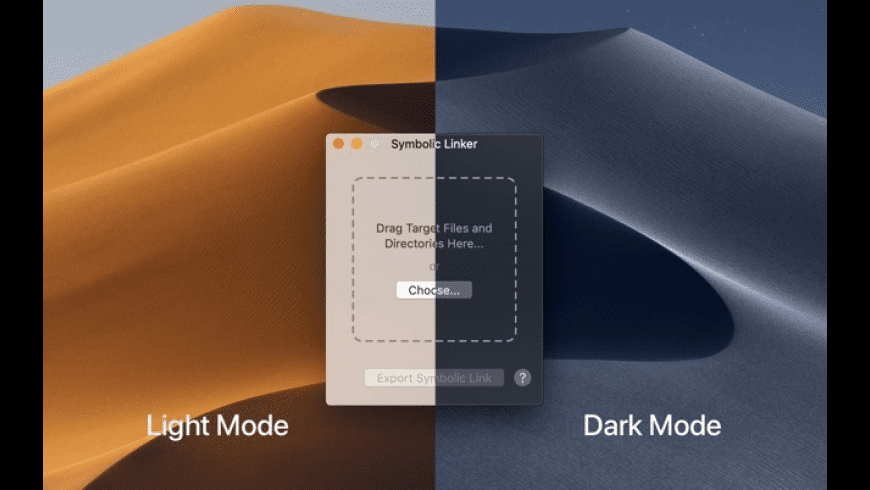At a Glance

Expert’s Rating
Cons
Our Verdict

When Apple made the transition from Mac OS 9 to Mac OS X, one of the under-the-hood consequences was that Mac aliases—tiny files that point to other files—lost some functionality. Or to put it more accurately, many of the Unix underpinnings of OS X don’t support Mac OS aliases: Unix programs and services see a Mac alias as just a useless little file. To get similar functionality with classic-Mac-unfriendly code, you need to use Unix-style symbolic links (also called symlinks or soft links).
Why might you need to use symbolic links if you tend to stick to Mac apps? As an example, a search for “symbolic link” on our own Mac OS X Hints site provides over 100 results—many of these hints and tips require you to create symbolic links instead of Mac aliases.
Links checked Symbolic Linker Symbolic Linker (2.0 V2) Activated On Mac OS X Download. To Macbook Sierra Full 2 0 V. SymbolicLinker is a tiny contextual menu plugin (for OS X 10.3.9 through 10.5.8) and software service (for OS X 10.6 or later) that, once installed, allows any user to create symbolic links to files inside the Finder. SymbolicLinker does this by adding a contextual menu item to the Finder that generates symbolic links to the selected files. SymbolicLinker is a tiny service that, once installed, allows any user to create symbolic links to files inside the Finder. It does this by adding a contextual-menu item to the Finder that generates symbolic links to the selected files. The goal of this product is to decrease users' trips to the Terminal in order to use the 'ln -s' command. Get Symbolic,Linker format - rar,stable #10.12'Sierra erprobasmetti89 2017-11-29 00:35 Symbolic Linker (2.0 v2) for iMac Yosemite 10.10 new version download. SymbolicLinker is a tiny contextual menu plugin that, once installed, allows any user to create symbolic links to files inside the Finder. SymbolicLinker does this by adding a contextual menu item to the Finder that generates symbolic links to the selected files.
The catch here is that while the Finder makes it easy to create aliases, it doesn’t provide a way to make symbolic links. The common approach to creating them is by using the ln -s command in Terminal. This can be intimidating to the Terminal-averse, but even if you don’t mind using Terminal, doing so can be a hassle (or at least a mild inconvenience) if you’re currently working in the Finder.
A simpler alternative is the free SymbolicLinker. Asian dynasties torrent. This OS X add-on—which is provided as a services plug-in for OS X 10.6 and later, and as a contextual-menu plug-in for OS X 10.5 and earlier—adds a Make Symbolic Link command to the Finder’s contextual menus. (In 10.5, the command is in the More submenu; in all other versions of OS X, it’s at the root level of the menu.) Just right-click or Control-click on an item in the Finder, choose Make Symbolic Link, and a link to that file is created. The link looks just like a Mac alias.
Exactly where the link is created depends on where the original item is located. It will usually appear in the same folder as the original file or folder; however, if you don’t have permission to create a new file in that directory, the link will be created on the Desktop. (I’d like to see an option to choose a default location for all new symlinks.) Wherever the link is created, you can then move it to wherever you like.
Be sure to read the included installation instructions, as the procedure differs depending on whether your Mac is running Snow Leopard (10.6) or an earlier version of OS X; in either case, it’s a straightforward process. If you occasionally find yourself creating symbolic links—or have ever wondered how to do so—SymbolicLinker is as easy as it gets.

Want to stay up to date with the latest Gems? Sign up for the Mac Gems newsletter for a weekly e-mail summary of Gems reviews sent directly to your Inbox.
-->A symbolic link is a file-system object that points to another file system object. The object being pointed to is called the target.
Scooter software beyond compare download. Symbolic links are transparent to users; the links appear as normal files or directories, and can be acted upon by the user or application in exactly the same manner.
Symbolic links are designed to aid in migration and application compatibility with UNIX operating systems. Microsoft has implemented its symbolic links to function just like UNIX links.
For more information, see the following topics.
In this section
| Topic | Description |
|---|---|
| Symbolic Link Effects on File Systems Functions | How symbolic links affect standard file functions that use path names to specify one or more files. |
| Programming Considerations | Programming considerations for working with symbolic links. |
| Creating Symbolic Links | Create symbolic links that use either an absolute or relative path by using the CreateSymbolicLink function. |
Supported Operating Systems
Symbolic Linker Mac
Symbolic links are available in NTFS starting with Windows Vista.
